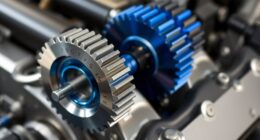Tuning your Mazda RX-8's rotary engine lets you access its true performance potential, enhancing both power and responsiveness. Start with carefully chosen upgrades like a high-quality ECU tune or a performance exhaust system. While some mods might offer minimal gains, others like supercharging or turbocharging can greatly boost output. Keep in mind that compatibility and installation quality are essential; improper mods can lead to engine damage. Regular maintenance, like oil changes and spark plug checks, is important for longevity, too. Stick around to discover practical tips and detailed insights to get the most out of your RX-8 tuning journey.
Key Takeaways
- Modifications for the RX-8 should align with performance goals and budget, considering each upgrade's unique benefits and drawbacks.
- ECU tuning options like COBB AccessPORT can yield significant horsepower gains and improve engine efficiency when correctly installed.
- Turbocharging significantly enhances the RX-8's capabilities, but requires careful consideration of compatibility and reliability with existing components.
- Upgrading the exhaust system improves airflow and performance, but removing the catalytic converter can lead to legal issues and engine warning lights.
- Engaging with the RX-8 community provides valuable insights and support for navigating tuning options and troubleshooting common engine issues.
Modding Basics and Considerations
When you're diving into modding your Mazda RX-8, it's essential to keep a few key considerations in mind.
First, remember that each modification has unique benefits and drawbacks. For instance, while upgrading your exhaust system might seem tempting, a catback exhaust priced at $800-$1,000 often yields negligible power gains. You'll want to guarantee that any upgrades effectively enhance your vehicle's performance.
Next, be cautious with engine tuning. Improper modifications can void your warranty, so do thorough research beforehand. If you lack experience, consulting a professional engine builder is highly recommended. They can guide you through the process, making sure you don't run into costly issues down the line.
Also, keep in mind that the RX-8's niche market leads to price disparities for performance parts compared to more common vehicles. Investing in high-quality components is vital, especially if you're looking to boost on pump fuel.
Cost Comparisons for Modifications

Modifying your Mazda RX-8 can quickly become a costly endeavor, especially when you factor in the price of performance parts. For example, if you're considering a catback exhaust, you might spend between $800 to $1,000, but don't expect significant power gains.
Cold air intakes range from $400 to $600, and while they can enhance airflow, the performance improvements are often minimal.
When looking at ECU modifications, anticipate costs between $500 to $800. These can provide limited horsepower increases, but proceed with caution, as improper installations might void warranties.
If you're after major horsepower upgrades, be prepared for even higher expenses. Options like nitrous systems might offer temporary boosts, but they come with risks of mechanical failure.
In cost comparisons to more common vehicles, like the Civic, you'll find that RX-8 performance parts generally carry a premium price due to its niche market.
Ultimately, every modification you consider should be weighed against its potential benefits and costs, ensuring you make informed choices that align with your performance goals and budget.
Series-Specific Differences

When tuning your Mazda RX-8, it's crucial to recognize the series-specific differences between the Series 1 and Series 2 models.
You'll find that while Series 1 features certain components, Series 2 introduces enhancements that improve performance and reliability.
Make sure any modifications you consider are compatible with your specific model to get the best results.
Series 1 Features
The Series 1 RX-8, produced from 2004 to 2008, stands out in the automotive landscape thanks to its distinctive 1.3L rotary engine. This lightweight engine offers high-revving capabilities, making it a favorite among performance enthusiasts.
One of the key features of the Series 1 is its oil metering pump (OMP) system, which plays an essential role in maintaining engine lubrication and performance.
You'll appreciate the variable exhaust system in the Series 1, as it not only affects the exhaust note but also helps manage back pressure, an important factor for tuning. The OEM intake system is highly effective, providing a solid foundation for performance upgrades.
While aftermarket options like the Mazdaspeed and AEM intakes can offer minimal gains of about 1-3.6hp, understanding the specifics of Series 1 modifications is significant for maximizing performance.
To truly reveal the potential of your rotary engine, consider exhaust porting methods and ECU tuning options. These modifications can elevate your RX-8's performance while ensuring you don't compromise engine reliability.
Embrace the unique characteristics of the Series 1 RX-8, and take your tuning journey to new heights!
Series 2 Enhancements
Significant enhancements in the Series 2 RX-8, produced from 2009 to 2012, make it a compelling choice for enthusiasts looking to elevate their driving experience.
With an upgraded engine and OMP system, the Series 2 offers improved reliability and performance over its predecessor. You'll appreciate the electronic enhancements that streamline engine management, allowing for better fuel economy and efficiency.
Consider these exciting features of the Series 2 RX-8:
- Enhanced engine reliability for peace of mind
- Improved fuel economy for longer drives
- Greater tuning potential with ECU options
These series 2 enhancements not only boost performance but also allow you to push your rotary engine to new limits.
The modified exhaust system can influence your aftermarket options, giving you the chance to customize your ride further. Plus, the availability of advanced tuning options since 2013 means you have the opportunity to tap into the full potential of your RX-8.
Understanding these enhancements is vital for maximizing your driving experience, ensuring you get the most out of your Series 2 RX-8.
Modifications Compatibility Issues
Understanding the enhancements of the Series 2 RX-8 sets the stage for maneuvering modifications compatibility issues between the two series. While both Series 1 and Series 2 share many components, key differences in the rotary engine, oil metering pump (OMP) system, and electronics can complicate your tuning experience.
For example, the exhaust systems vary greatly. If you're considering aftermarket parts, knowing these distinctions is crucial for effective performance upgrades. Installing parts that don't align with your specific series could lead to overheating or damage.
Here's a quick reference table to help you navigate some of these compatibility issues:
| Component | Series 1 Compatibility | Series 2 Compatibility |
|---|---|---|
| Exhaust Systems | Limited | Specific fit |
| Aftermarket Intakes | Mazdaspeed only | AEM compatible |
| Long Tube Headers | Requires modifications | Direct fit |
| Porting Methods | Engine-specific | Must match series |
When selecting modifications, always prioritize compatibility to maximize your RX-8's performance and longevity.
Exhaust and Emissions Upgrades

Upgrading your Mazda RX-8's exhaust system can open up a new level of engine performance and deliver a thrilling sound. With an aftermarket exhaust, you'll enjoy improved airflow and enhanced power.
However, be mindful of the choices you make, especially regarding the catalytic converter.
Consider these key factors:
- Power Boost: An upgraded exhaust can release more horsepower, making your driving experience exhilarating.
- Sound Profile: The RX-8's distinctive roar can be enhanced or modified using various resonators to match your personal style.
- Legal Concerns: Removing the catalytic converter may seem tempting for power, but it can lead to check engine lights and legal issues.
When choosing resonators, you'll find options like the BHR single resonated, Agency Power dual resonated, and Racing Beat dual resonated. Each has a unique sound profile but doesn't guarantee performance boosts.
Remember, it's wise to research aftermarket catalytic converters thoroughly, as improper modifications can lead to significant complications.
Tuning Options and Enhancements

When it comes to tuning your Mazda RX-8, there are several exciting options to contemplate that can enhance performance and driving enjoyment. One popular choice is ECU tuning, with options like the COBB AccessPORT and MazdaEdit. These tuning options typically yield around 10hp gains, offering a noticeable boost in performance without extensive modifications.
If you're looking for more power, supercharging kits, such as the Pettit supercharger, are worth considering. Priced over $7,000, these kits require additional modifications to guarantee reliability and peak performance, but they can greatly elevate your RX-8's capabilities.
While turbocharging options are limited, the GReddy kit featuring a 3071R turbine is a notable choice, albeit with a budget of around $10,000 for installation and related enhancements.
For those focused on improving engine responsiveness, lightweight flywheels are excellent performance upgrades, although they don't directly increase power. Be cautious if you're inexperienced with manual driving, as they can lead to potential stalling issues.
Engine Performance Issues

Experiencing engine performance issues with your Mazda RX-8 can be frustrating, especially given the unique challenges posed by its rotary design. Common problems like rough idling or excessive oil consumption can quickly become a headache, often signaling deeper issues with your engine.
- You might notice high oil consumption, averaging 1 quart per 1,000 miles.
- High EGTs can lead to overheating and damage to essential components.
- Apex seal failures could mean costly repairs and downtime.
These engine performance issues are often linked to the RX-8's specific needs. Ignoring signs such as check engine lights could lead to significant damage, including oil seal failure and compression loss from overboosting.
It's imperative to monitor boost levels and guarantee proper tuning to maintain performance. On top of that, high temperatures during warm weather can exacerbate the situation, impacting your catalytic converter and overall engine health.
Staying vigilant about these factors can help you push the limits of your rotary engine while minimizing the risk of premature failures and costly rebuilds.
Addressing these concerns early will keep your RX-8 running smoothly and efficiently.
Fuel and Boost Management

Addressing engine performance issues often leads to the need for effective fuel and boost management in your Mazda RX-8. Proper management is essential, especially if you're looking to enhance performance. Start by making sure that you're using high-octane fuel, like 93 octane, which is critical for supporting higher boost levels. The stock RX-8 engine can handle about 15 PSI safely, so push those limits cautiously.
Regularly monitor your fuel pressure, as fluctuations can disrupt the air-fuel mixture across the rotors, potentially causing engine damage. If you're considering running boost levels beyond 15 PSI on pump gas, incorporating water/methanol injection can help mitigate knock and improve performance.
Don't overlook the importance of maintaining your ignition components. At elevated boost levels, make sure that your spark plugs and wires are in top condition to minimize the risk of misfires and crossfires.
Managing fuel and boost effectively will help you squeeze every bit of performance from your RX-8 while keeping it safe from potential damage. By following these guidelines, you're on the right path to achieving the thrill of rotary engine tuning.
Sensor Functionality and Monitoring

When tuning your Mazda RX-8, understanding the knock sensor's functionality is key to preventing engine damage.
You'll need to monitor detonation effectively, as excessive knocking can lead to serious issues, especially in high-performance setups.
Knock Sensor Insights
The knock sensor in the Mazda RX-8 plays an important role in maintaining engine performance and longevity. By providing voltage readings that indicate knock or detonation conditions, it acts as your engine's guardian. This sensor generates sinusoidal signals that help monitor engine health in real-time, allowing you to make significant adjustments to ignition timing and fuel mixture.
Effective monitoring of the knock sensor is essential, as it helps prevent potential engine damage. To enhance your RX-8's performance, consider the following:
- Real-time data: Stay ahead of potential issues with immediate feedback.
- Improved tuning: Fine-tune your engine for peak performance.
- Longevity: Extend your engine's life by proactively managing knock.
Sample rate issues can create challenges in interpreting knock sensor data, which is why investing in reliable aftermarket systems or advanced engine management systems (EMS) is a smart choice.
Community insights also suggest repurposing the knock sensor for logging purposes, enabling you to track your engine's health and performance under various tuning conditions.
Monitoring Detonation Effectively
Effective detonation monitoring is essential for maximizing your Mazda RX-8's performance while safeguarding its engine. The knock sensor plays a critical role here, functioning like a temperature sensor by providing voltage readings to detect detonation events.
By actively monitoring this data, you can prevent excessive detonation, which can lead to severe engine damage, including broken apex seals or damaged bearings.
To enhance the accuracy of knock signal interpretation, consider installing aftermarket knock sensor systems or an Engine Management System (EMS). These tools offer better protection for high-performance setups, ensuring your engine remains in prime condition.
However, be aware that sample rate issues can complicate the interpretation of knock sensor data, so reliability is key. Investing in high-quality equipment will improve your monitoring efforts considerably.
Engaging with knowledgeable rotary tuners can further refine your approach to detonation monitoring. They can provide valuable insights into maintaining appropriate ignition timing during high boost conditions, which is essential for preventing detonation.
Community Insights and Support

Engaging with the RX-8 community can greatly enhance your tuning journey by providing valuable insights and support. You'll find a wealth of knowledge as fellow enthusiasts share their experiences, troubleshooting advice, and performance modifications specifically for rotary engines. This collective wisdom can help you avoid common pitfalls and optimize your tuning efforts.
Here are a few reasons to connect with the community:
- Shared Experiences: Learn from others' successes and failures in rotary engine tuning.
- Trusted Resources: Get recommendations for expert tuners like Japtrix, known for their skill in RX-8 performance enhancements.
- Documentation: Understand the importance of recording your tuning journey, making it easier to address recurring issues.
While online forums can sometimes spread misinformation, the RX-8 community emphasizes seeking advice from knowledgeable individuals. By tapping into community insights, you can enhance your understanding of performance modifications and guarantee your rotary engine operates at its best.
Don't hesitate to share your tuning data, too; it fosters a supportive environment where everyone can learn and grow together.
Maintenance for Longevity

Connecting with the RX-8 community not only enriches your tuning experience but also highlights the significance of maintenance for your vehicle's longevity.
Regular oil changes are essential; aim to change the oil every 3,000 miles, using high-quality synthetic oil for better engine protection. Don't overlook your coolant levels, either—keeping them in check prevents overheating, and replacing coolant every two years helps maintain peak performance.
Implementing a premix oil system can greatly enhance engine longevity. By adding 4 oz of oil per 10 gallons of fuel, you'll reduce wear on the rotary components.
A clean air filter is crucial as well; a clogged filter restricts airflow, negatively impacting engine performance and efficiency. Regularly checking and replacing your air filter guarantees your RX-8 breathes easy.
Additionally, keep tabs on your spark plugs. Replacing worn or fouled plugs can prevent ignition issues, contributing to improved engine reliability.
Frequently Asked Questions
How Much HP Can You Get Out of a Mazda Rx-8?
You can get around 232 horsepower from a stock Mazda RX-8, but with tuning and modifications, you might push it to over 300 horsepower, and some setups even reach up to 374 horsepower with turbocharging.
How Much Power Can a RX-8 Make?
You can make your RX-8 produce between 300 to 400 horsepower with tuning and modifications. High-performance builds, especially with turbocharging, might even exceed 400 horsepower, but remember, reliability and maintenance are essential for longevity.
What Is the Weakness of the Rotary Engine?
The rotary engine's weaknesses include high oil consumption, overheating risks, and apex seal wear. You might face compression loss and frequent rebuilds, especially if you don't follow the recommended oil guidelines or maintenance schedule.
What Is the Biggest Problem With Rotary Engines?
The biggest problem with rotary engines is their reliability. You'll notice high oil consumption, frequent rebuilds, and overheating issues. These factors can lead to performance failures and costly repairs, impacting your overall driving experience.
Conclusion
In your quest to access the full potential of your Mazda RX-8, remember that every tweak and upgrade can lead to surprising results. Just like finding that perfect tuning setup, you might stumble upon a community of passionate enthusiasts who share your journey. Embrace the coincidences—like meeting someone at a car meet who has the same mods or discovering a hidden gem of advice online. With the right care and modifications, your rotary engine can truly shine.










